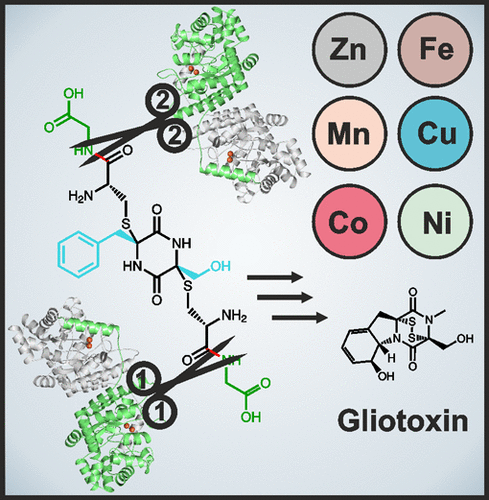当前位置:
X-MOL 学术
›
ACS Chem. Biol.
›
论文详情
Our official English website, www.x-mol.net, welcomes your
feedback! (Note: you will need to create a separate account there.)
Gliotoxin Biosynthesis: Structure, Mechanism, and Metal Promiscuity of Carboxypeptidase GliJ
ACS Chemical Biology ( IF 3.5 ) Pub Date : 2017-05-19 00:00:00 , DOI: 10.1021/acschembio.6b00847 Antoine Marion 1 , Michael Groll 2 , Daniel H. Scharf 3 , Kirstin Scherlach 4 , Manuel Glaser 1 , Holger Sievers 5 , Michael Schuster 5 , Christian Hertweck 4, 6 , Axel A. Brakhage 3, 7 , Iris Antes 1 , Eva M. Huber 2
ACS Chemical Biology ( IF 3.5 ) Pub Date : 2017-05-19 00:00:00 , DOI: 10.1021/acschembio.6b00847 Antoine Marion 1 , Michael Groll 2 , Daniel H. Scharf 3 , Kirstin Scherlach 4 , Manuel Glaser 1 , Holger Sievers 5 , Michael Schuster 5 , Christian Hertweck 4, 6 , Axel A. Brakhage 3, 7 , Iris Antes 1 , Eva M. Huber 2
Affiliation

|
The formation of glutathione (GSH) conjugates, best known from the detoxification of xenobiotics, is a widespread strategy to incorporate sulfur into biomolecules. The biosynthesis of gliotoxin, a virulence factor of the human pathogenic fungus Aspergillus fumigatus, involves attachment of two GSH molecules and their sequential decomposition to yield two reactive thiol groups. The degradation of the GSH moieties requires the activity of the Cys–Gly carboxypeptidase GliJ, for which we describe the X-ray structure here. The enzyme forms a homodimer with each monomer comprising one active site. Two metal ions are present per proteolytic center, thus assigning GliJ to the diverse family of dinuclear metallohydrolases. Depending on availability, Zn2+, Fe2+, Fe3+, Mn2+, Cu2+, Co2+, or Ni2+ ions are accepted as cofactors. Despite this high metal promiscuity, a preference for zinc versus iron and manganese was noted. Mutagenesis experiments revealed details of metal coordination, and molecular modeling delivered insights into substrate recognition and processing by GliJ. The latter results suggest a reaction mechanism in which the two scissile peptide bonds of one gliotoxin precursor molecule are hydrolyzed sequentially and in a given order.
中文翻译:

胶质毒素生物合成:羧肽酶GliJ的结构,机理和金属滥交。
谷胱甘肽(GSH)缀合物的形成,是从异种生物的解毒过程中最广为人知的,是一种将硫掺入生物分子中的广泛策略。胶体毒素的生物合成是人致病性真菌烟曲霉的一种致病因子,它涉及两个GSH分子的附着及其顺序分解,从而产生两个反应性硫醇基团。谷胱甘肽部分的降解需要Cys-Gly羧肽酶GliJ的活性,我们在此描述其X射线结构。该酶与每个单体包含一个活性位点形成同型二聚体。每个蛋白水解中心存在两个金属离子,因此将GliJ分配给双核金属水解酶的各种家族。取决于可用性,Zn 2 +,Fe 2 +,Fe可以接受3+,Mn 2 +,Cu 2 +,Co 2+或Ni 2+离子作为辅助因子。尽管金属的混杂程度很高,但人们还是注意到锌相对于铁和锰的偏爱。诱变实验揭示了金属配位的细节,分子模型为GliJ对底物的识别和处理提供了见识。后者的结果提示了一种反应机理,其中一个胶质毒素前体分子的两个易裂肽键按给定顺序依次水解。
更新日期:2017-06-28
中文翻译:

胶质毒素生物合成:羧肽酶GliJ的结构,机理和金属滥交。
谷胱甘肽(GSH)缀合物的形成,是从异种生物的解毒过程中最广为人知的,是一种将硫掺入生物分子中的广泛策略。胶体毒素的生物合成是人致病性真菌烟曲霉的一种致病因子,它涉及两个GSH分子的附着及其顺序分解,从而产生两个反应性硫醇基团。谷胱甘肽部分的降解需要Cys-Gly羧肽酶GliJ的活性,我们在此描述其X射线结构。该酶与每个单体包含一个活性位点形成同型二聚体。每个蛋白水解中心存在两个金属离子,因此将GliJ分配给双核金属水解酶的各种家族。取决于可用性,Zn 2 +,Fe 2 +,Fe可以接受3+,Mn 2 +,Cu 2 +,Co 2+或Ni 2+离子作为辅助因子。尽管金属的混杂程度很高,但人们还是注意到锌相对于铁和锰的偏爱。诱变实验揭示了金属配位的细节,分子模型为GliJ对底物的识别和处理提供了见识。后者的结果提示了一种反应机理,其中一个胶质毒素前体分子的两个易裂肽键按给定顺序依次水解。































 京公网安备 11010802027423号
京公网安备 11010802027423号